FIAT DOBLO COMBI 2010 Owner handbook (in English)
Manufacturer: FIAT, Model Year: 2010, Model line: DOBLO COMBI, Model: FIAT DOBLO COMBI 2010Pages: 274, PDF Size: 6.16 MB
Page 131 of 274
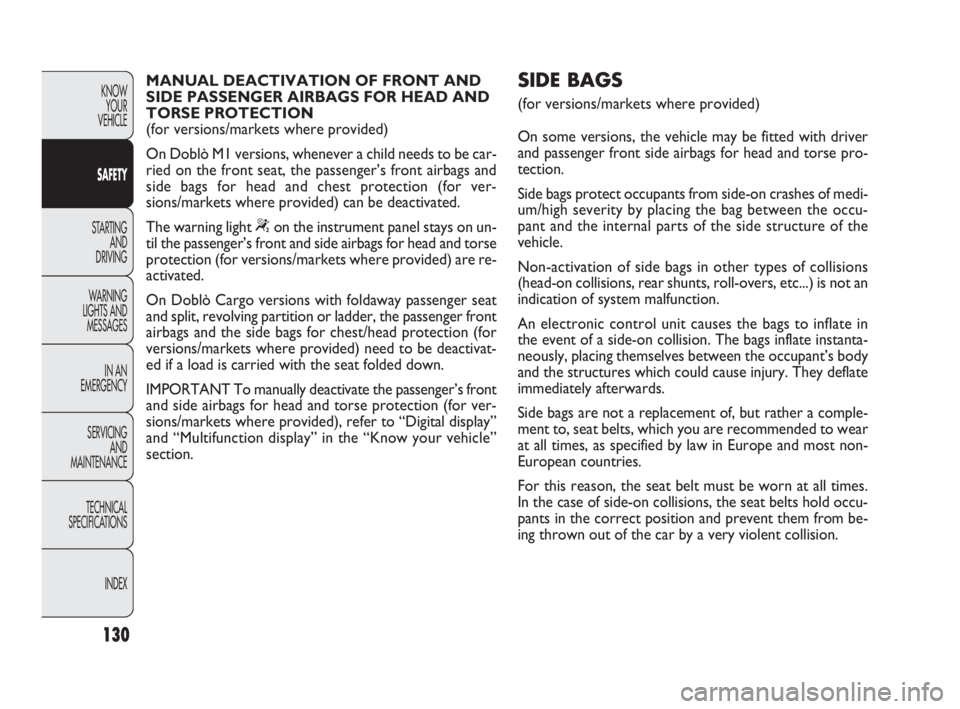
130
KNOW
YOUR
VEHICLE
SAFETY
STARTING
AND
DRIVING
WARNING
LIGHTS AND
MESSAGES
IN AN
EMERGENCY
SERVICING
AND
MAINTENANCE
TECHNICAL
SPECIFICATIONS
INDEX
MANUAL DEACTIVATION OF FRONT AND
SIDE PASSENGER AIRBAGS FOR HEAD AND
TORSE PROTECTION
(for versions/markets where provided)
On Doblò M1 versions, whenever a child needs to be car-
ried on the front seat, the passenger’s front airbags and
side bags for head and chest protection (for ver-
sions/markets where provided) can be deactivated.
The warning light
“on the instrument panel stays on un-
til the passenger’s front and side airbags for head and torse
protection (for versions/markets where provided) are re-
activated.
On Doblò Cargo versions with foldaway passenger seat
and split, revolving partition or ladder, the passenger front
airbags and the side bags for chest/head protection (for
versions/markets where provided) need to be deactivat-
ed if a load is carried with the seat folded down.
IMPORTANT To manually deactivate the passenger’s front
and side airbags for head and torse protection (for ver-
sions/markets where provided), refer to “Digital display”
and “Multifunction display” in the “Know your vehicle”
section.
SIDE BAGS
(for versions/markets where provided)
On some versions, the vehicle may be fitted with driver
and passenger front side airbags for head and torse pro-
tection.
Side bags protect occupants from side-on crashes of medi-
um/high severity by placing the bag between the occu-
pant and the internal parts of the side structure of the
vehicle.
Non-activation of side bags in other types of collisions
(head-on collisions, rear shunts, roll-overs, etc...) is not an
indication of system malfunction.
An electronic control unit causes the bags to inflate in
the event of a side-on collision. The bags inflate instanta-
neously, placing themselves between the occupant’s body
and the structures which could cause injury. They deflate
immediately afterwards.
Side bags are not a replacement of, but rather a comple-
ment to, seat belts, which you are recommended to wear
at all times, as specified by law in Europe and most non-
European countries.
For this reason, the seat belt must be worn at all times.
In the case of side-on collisions, the seat belts hold occu-
pants in the correct position and prevent them from be-
ing thrown out of the car by a very violent collision.
115-132 DOBLO LUM EN 2e 7.0 21-05-2010 11:11 Pagina 130
Page 132 of 274
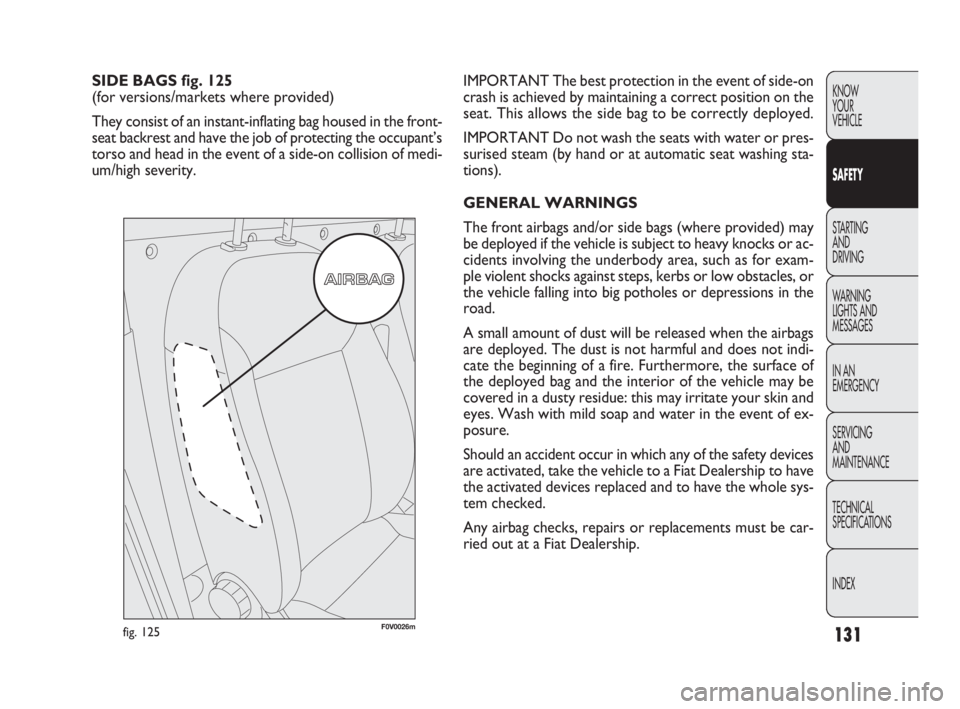
131
KNOW
YOUR
VEHICLE
SAFETY
STARTING
AND
DRIVING
WARNING
LIGHTS AND
MESSAGES
IN AN
EMERGENCY
SERVICING
AND
MAINTENANCE
TECHNICAL
SPECIFICATIONS
INDEX
IMPORTANT The best protection in the event of side-on
crash is achieved by maintaining a correct position on the
seat. This allows the side bag to be correctly deployed.
IMPORTANT Do not wash the seats with water or pres-
surised steam (by hand or at automatic seat washing sta-
tions).
GENERAL WARNINGS
The front airbags and/or side bags (where provided) may
be deployed if the vehicle is subject to heavy knocks or ac-
cidents involving the underbody area, such as for exam-
ple violent shocks against steps, kerbs or low obstacles, or
the vehicle falling into big potholes or depressions in the
road.
A small amount of dust will be released when the airbags
are deployed. The dust is not harmful and does not indi-
cate the beginning of a fire. Furthermore, the surface of
the deployed bag and the interior of the vehicle may be
covered in a dusty residue: this may irritate your skin and
eyes. Wash with mild soap and water in the event of ex-
posure.
Should an accident occur in which any of the safety devices
are activated, take the vehicle to a Fiat Dealership to have
the activated devices replaced and to have the whole sys-
tem checked.
Any airbag checks, repairs or replacements must be car-
ried out at a Fiat Dealership. SIDE BAGS fig. 125
(for versions/markets where provided)
They consist of an instant-inflating bag housed in the front-
seat backrest and have the job of protecting the occupant’s
torso and head in the event of a side-on collision of medi-
um/high severity.
F0V0026mfig. 125
115-132 DOBLO LUM EN 2e 7.0 21-05-2010 11:11 Pagina 131
Page 133 of 274
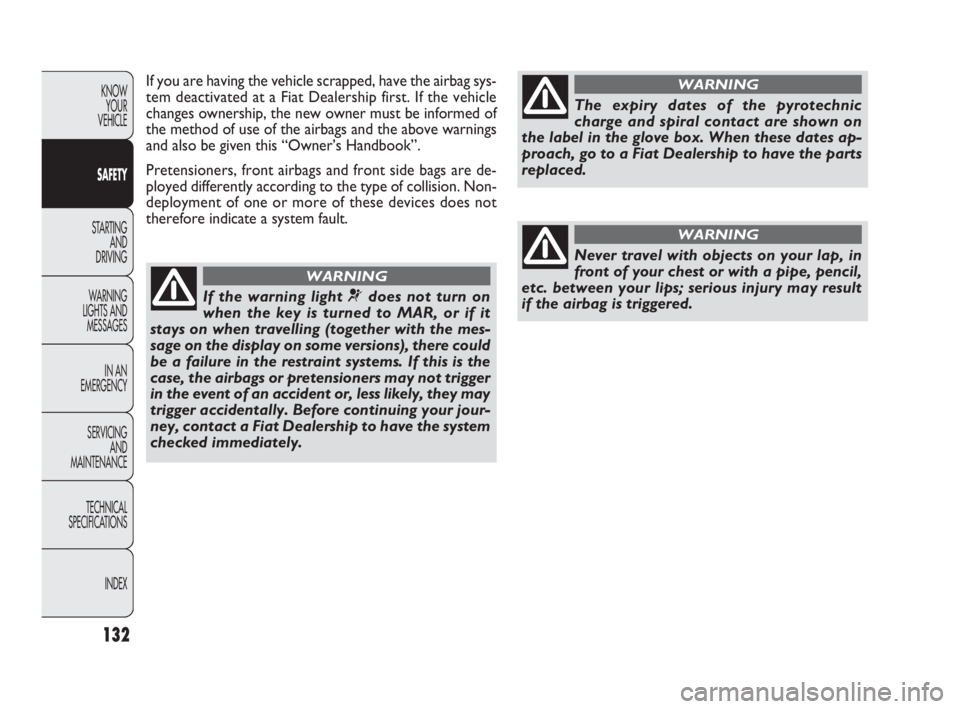
132
KNOW
YOUR
VEHICLE
SAFETY
STARTING
AND
DRIVING
WARNING
LIGHTS AND
MESSAGES
IN AN
EMERGENCY
SERVICING
AND
MAINTENANCE
TECHNICAL
SPECIFICATIONS
INDEX
If you are having the vehicle scrapped, have the airbag sys-
tem deactivated at a Fiat Dealership first. If the vehicle
changes ownership, the new owner must be informed of
the method of use of the airbags and the above warnings
and also be given this “Owner’s Handbook”.
Pretensioners, front airbags and front side bags are de-
ployed differently according to the type of collision. Non-
deployment of one or more of these devices does not
therefore indicate a system fault.
If the warning light ¬does not turn on
when the key is turned to MAR, or if it
stays on when travelling (together with the mes-
sage on the display on some versions), there could
be a failure in the restraint systems. If this is the
case, the airbags or pretensioners may not trigger
in the event of an accident or, less likely, they may
trigger accidentally. Before continuing your jour-
ney, contact a Fiat Dealership to have the system
checked immediately.
WARNING
The expiry dates of the pyrotechnic
charge and spiral contact are shown on
the label in the glove box. When these dates ap-
proach, go to a Fiat Dealership to have the parts
replaced.
WARNING
Never travel with objects on your lap, in
front of your chest or with a pipe, pencil,
etc. between your lips; serious injury may result
if the airbag is triggered.
WARNING
115-132 DOBLO LUM EN 2e 7.0 21-05-2010 11:11 Pagina 132
Page 134 of 274
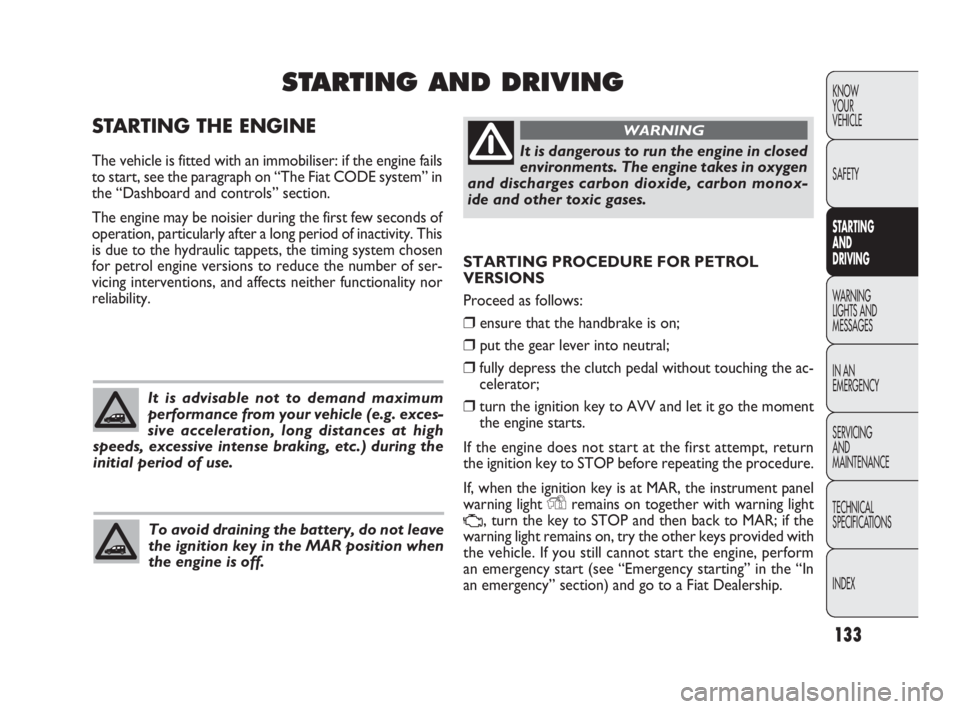
133
KNOW
YOUR
VEHICLE
SAFETY
STARTING
AND
DRIVING
WARNING
LIGHTS AND
MESSAGES
IN AN
EMERGENCY
SERVICING
AND
MAINTENANCE
TECHNICAL
SPECIFICATIONS
INDEX
STARTING PROCEDURE FOR PETROL
VERSIONS
Proceed as follows:
❒ensure that the handbrake is on;
❒put the gear lever into neutral;
❒fully depress the clutch pedal without touching the ac-
celerator;
❒turn the ignition key to AVV and let it go the moment
the engine starts.
If the engine does not start at the first attempt, return
the ignition key to STOP before repeating the procedure.
If, when the ignition key is at MAR, the instrument panel
warning light
Yremains on together with warning light
U, turn the key to STOP and then back to MAR; if the
warning light remains on, try the other keys provided with
the vehicle. If you still cannot start the engine, perform
an emergency start (see “Emergency starting” in the “In
an emergency” section) and go to a Fiat Dealership.
STARTING THE ENGINE
The vehicle is fitted with an immobiliser: if the engine fails
to start, see the paragraph on “The Fiat CODE system” in
the “Dashboard and controls” section.
The engine may be noisier during the first few seconds of
operation, particularly after a long period of inactivity. This
is due to the hydraulic tappets, the timing system chosen
for petrol engine versions to reduce the number of ser-
vicing interventions, and affects neither functionality nor
reliability.
STARTING AND DRIVING
It is advisable not to demand maximum
performance from your vehicle (e.g. exces-
sive acceleration, long distances at high
speeds, excessive intense braking, etc.) during the
initial period of use.
To avoid draining the battery, do not leave
the ignition key in the MAR position when
the engine is off.
It is dangerous to run the engine in closed
environments. The engine takes in oxygen
and discharges carbon dioxide, carbon monox-
ide and other toxic gases.
WARNING
133-142 DOBLO LUM EN 2e 7.0 21-05-2010 11:12 Pagina 133
Page 135 of 274
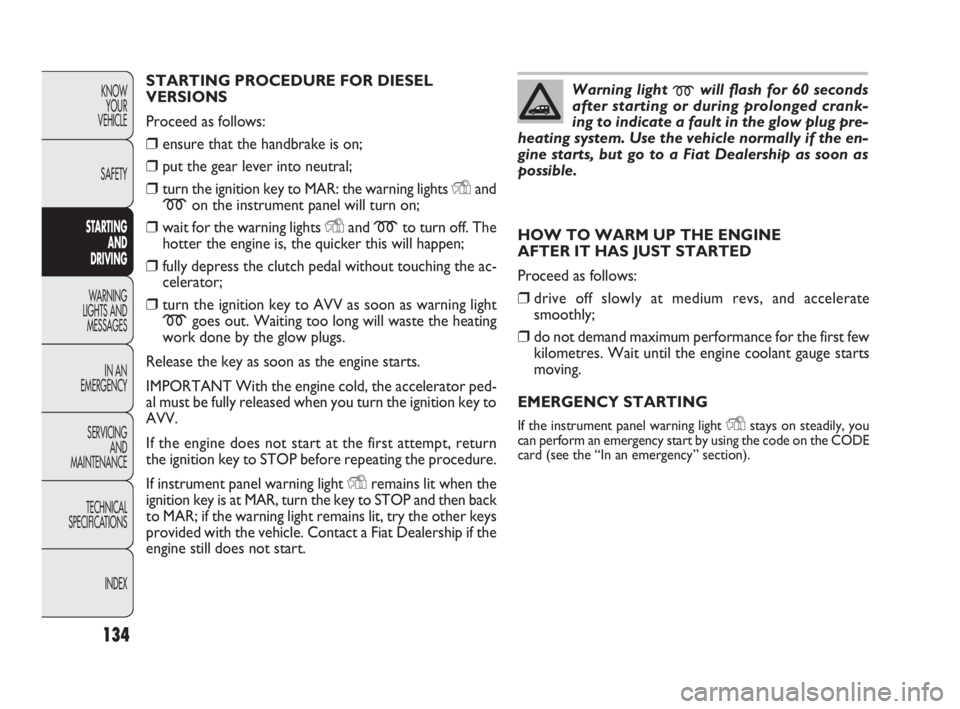
134
KNOW
YOUR
VEHICLE
SAFETY
STARTING
AND
DRIVING
WARNING
LIGHTS AND
MESSAGES
IN AN
EMERGENCY
SERVICING
AND
MAINTENANCE
TECHNICAL
SPECIFICATIONS
INDEX
STARTING PROCEDURE FOR DIESEL
VERSIONS
Proceed as follows:
❒ensure that the handbrake is on;
❒put the gear lever into neutral;
❒turn the ignition key to MAR: the warning lights Yand
mon the instrument panel will turn on;
❒wait for the warning lights Yand mto turn off. The
hotter the engine is, the quicker this will happen;
❒fully depress the clutch pedal without touching the ac-
celerator;
❒turn the ignition key to AVV as soon as warning light
mgoes out. Waiting too long will waste the heating
work done by the glow plugs.
Release the key as soon as the engine starts.
IMPORTANT With the engine cold, the accelerator ped-
al must be fully released when you turn the ignition key to
AVV.
If the engine does not start at the first attempt, return
the ignition key to STOP before repeating the procedure.
If instrument panel warning light
Yremains lit when the
ignition key is at MAR, turn the key to STOP and then back
to MAR; if the warning light remains lit, try the other keys
provided with the vehicle. Contact a Fiat Dealership if the
engine still does not start.
Warning light mwill flash for 60 seconds
after starting or during prolonged crank-
ing to indicate a fault in the glow plug pre-
heating system. Use the vehicle normally if the en-
gine starts, but go to a Fiat Dealership as soon as
possible.
HOW TO WARM UP THE ENGINE
AFTER IT HAS JUST STARTED
Proceed as follows:
❒drive off slowly at medium revs, and accelerate
smoothly;
❒do not demand maximum performance for the first few
kilometres. Wait until the engine coolant gauge starts
moving.
EMERGENCY STARTING
If the instrument panel warning light Ystays on steadily, you
can perform an emergency start by using the code on the CODE
card (see the “In an emergency” section).
133-142 DOBLO LUM EN 2e 7.0 21-05-2010 11:12 Pagina 134
Page 136 of 274
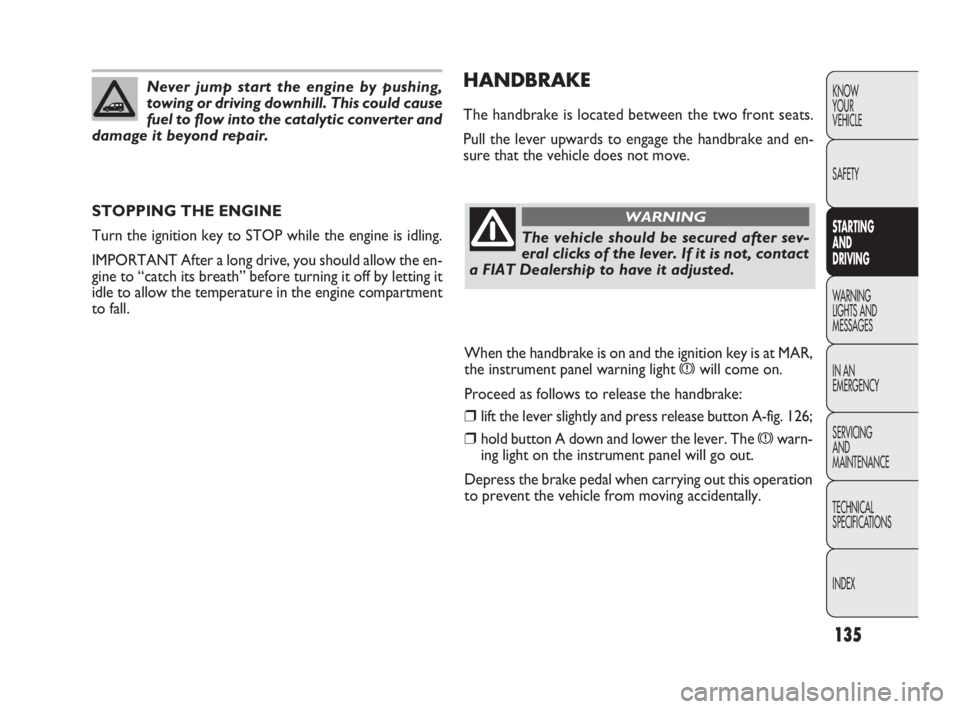
135
KNOW
YOUR
VEHICLE
SAFETY
STARTING
AND
DRIVING
WARNING
LIGHTS AND
MESSAGES
IN AN
EMERGENCY
SERVICING
AND
MAINTENANCE
TECHNICAL
SPECIFICATIONS
INDEX
HANDBRAKE
The handbrake is located between the two front seats.
Pull the lever upwards to engage the handbrake and en-
sure that the vehicle does not move.
STOPPING THE ENGINE
Turn the ignition key to STOP while the engine is idling.
IMPORTANT After a long drive, you should allow the en-
gine to “catch its breath” before turning it off by letting it
idle to allow the temperature in the engine compartment
to fall.
Never jump start the engine by pushing,
towing or driving downhill. This could cause
fuel to flow into the catalytic converter and
damage it beyond repair.
The vehicle should be secured after sev-
eral clicks of the lever. If it is not, contact
a FIAT Dealership to have it adjusted.
WARNING
When the handbrake is on and the ignition key is at MAR,
the instrument panel warning light
xwill come on.
Proceed as follows to release the handbrake:
❒lift the lever slightly and press release button A-fig. 126;
❒hold button A down and lower the lever. The xwarn-
ing light on the instrument panel will go out.
Depress the brake pedal when carrying out this operation
to prevent the vehicle from moving accidentally.
133-142 DOBLO LUM EN 2e 7.0 21-05-2010 11:12 Pagina 135
Page 137 of 274
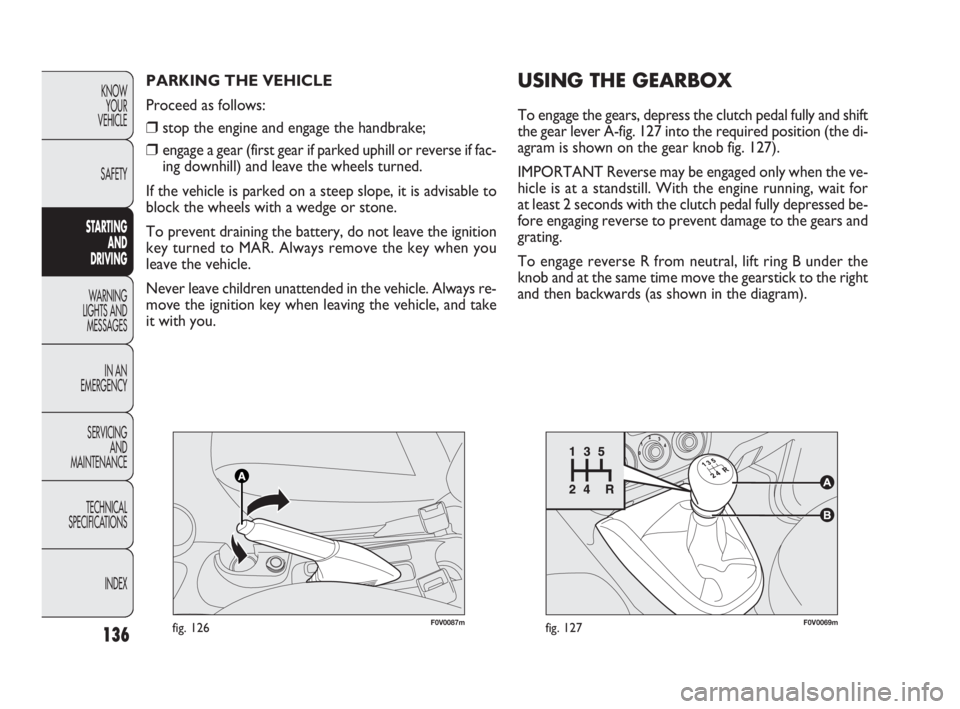
136
KNOW
YOUR
VEHICLE
SAFETY
STARTING
AND
DRIVING
WARNING
LIGHTS AND
MESSAGES
IN AN
EMERGENCY
SERVICING
AND
MAINTENANCE
TECHNICAL
SPECIFICATIONS
INDEX
F0V0069mfig. 127F0V0087mfig. 126
PARKING THE VEHICLE
Proceed as follows:
❒stop the engine and engage the handbrake;
❒engage a gear (first gear if parked uphill or reverse if fac-
ing downhill) and leave the wheels turned.
If the vehicle is parked on a steep slope, it is advisable to
block the wheels with a wedge or stone.
To prevent draining the battery, do not leave the ignition
key turned to MAR. Always remove the key when you
leave the vehicle.
Never leave children unattended in the vehicle. Always re-
move the ignition key when leaving the vehicle, and take
it with you.
USING THE GEARBOX
To engage the gears, depress the clutch pedal fully and shift
the gear lever A-fig. 127 into the required position (the di-
agram is shown on the gear knob fig. 127).
IMPORTANT Reverse may be engaged only when the ve-
hicle is at a standstill. With the engine running, wait for
at least 2 seconds with the clutch pedal fully depressed be-
fore engaging reverse to prevent damage to the gears and
grating.
To engage reverse R from neutral, lift ring B under the
knob and at the same time move the gearstick to the right
and then backwards (as shown in the diagram).
133-142 DOBLO LUM EN 2e 7.0 21-05-2010 11:12 Pagina 136
Page 138 of 274
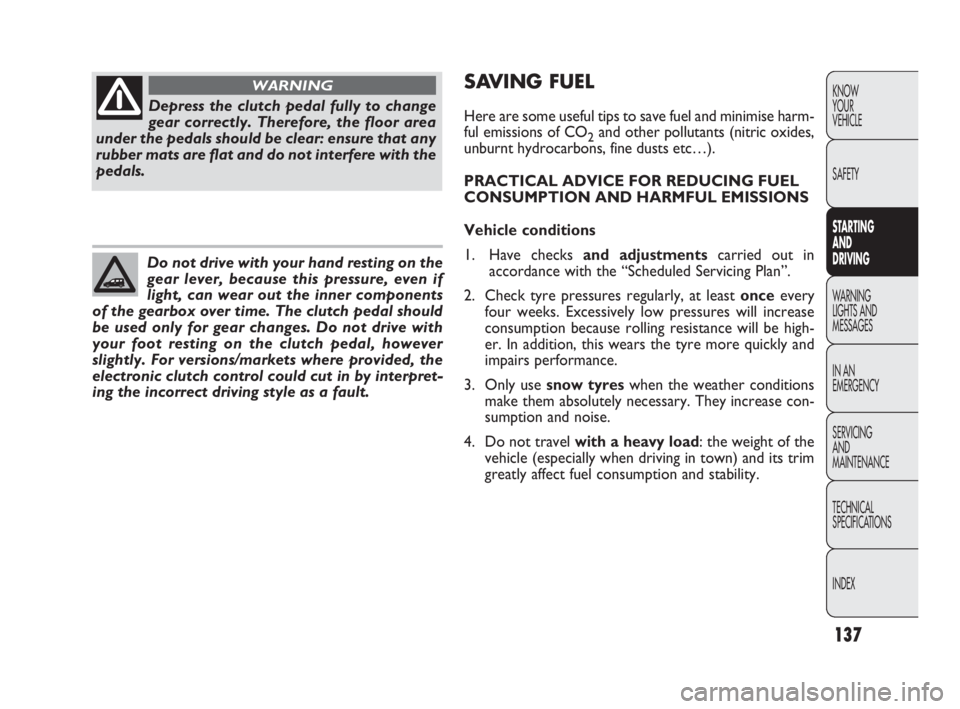
137
KNOW
YOUR
VEHICLE
SAFETY
STARTING
AND
DRIVING
WARNING
LIGHTS AND
MESSAGES
IN AN
EMERGENCY
SERVICING
AND
MAINTENANCE
TECHNICAL
SPECIFICATIONS
INDEX
Depress the clutch pedal fully to change
gear correctly. Therefore, the floor area
under the pedals should be clear: ensure that any
rubber mats are flat and do not interfere with the
pedals.
WARNING
Do not drive with your hand resting on the
gear lever, because this pressure, even if
light, can wear out the inner components
of the gearbox over time. The clutch pedal should
be used only for gear changes. Do not drive with
your foot resting on the clutch pedal, however
slightly. For versions/markets where provided, the
electronic clutch control could cut in by interpret-
ing the incorrect driving style as a fault.
SAVING FUEL
Here are some useful tips to save fuel and minimise harm-
ful emissions of CO
2and other pollutants (nitric oxides,
unburnt hydrocarbons, fine dusts etc…).
PRACTICAL ADVICE FOR REDUCING FUEL
CONSUMPTION AND HARMFUL EMISSIONS
Vehicle conditions
1. Have checks and adjustments carried out in
accordance with the “Scheduled Servicing Plan”.
2. Check tyre pressures regularly, at least once every
four weeks. Excessively low pressures will increase
consumption because rolling resistance will be high-
er. In addition, this wears the tyre more quickly and
impairs performance.
3. Only use snow tyreswhen the weather conditions
make them absolutely necessary. They increase con-
sumption and noise.
4. Do not travel with a heavy load: the weight of the
vehicle (especially when driving in town) and its trim
greatly affect fuel consumption and stability.
133-142 DOBLO LUM EN 2e 7.0 21-05-2010 11:12 Pagina 137
Page 139 of 274
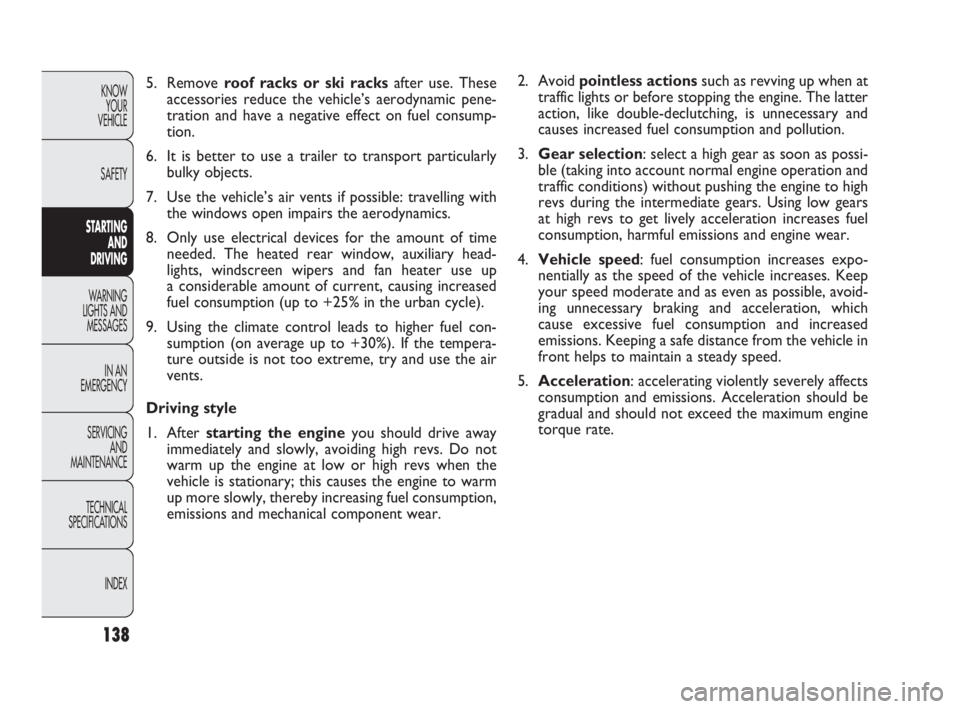
138
KNOW
YOUR
VEHICLE
SAFETY
STARTING
AND
DRIVING
WARNING
LIGHTS AND
MESSAGES
IN AN
EMERGENCY
SERVICING
AND
MAINTENANCE
TECHNICAL
SPECIFICATIONS
INDEX
2. Avoid pointless actions such as revving up when at
traffic lights or before stopping the engine. The latter
action, like double-declutching, is unnecessary and
causes increased fuel consumption and pollution.
3.Gear selection: select a high gear as soon as possi-
ble (taking into account normal engine operation and
traffic conditions) without pushing the engine to high
revs during the intermediate gears. Using low gears
at high revs to get lively acceleration increases fuel
consumption, harmful emissions and engine wear.
4.Vehicle speed: fuel consumption increases expo-
nentially as the speed of the vehicle increases. Keep
your speed moderate and as even as possible, avoid-
ing unnecessary braking and acceleration, which
cause excessive fuel consumption and increased
emissions. Keeping a safe distance from the vehicle in
front helps to maintain a steady speed.
5.Acceleration: accelerating violently severely affects
consumption and emissions. Acceleration should be
gradual and should not exceed the maximum engine
torque rate. 5. Remove roof racks or ski racksafter use. These
accessories reduce the vehicle’s aerodynamic pene-
tration and have a negative effect on fuel consump-
tion.
6. It is better to use a trailer to transport particularly
bulky objects.
7. Use the vehicle’s air vents if possible: travelling with
the windows open impairs the aerodynamics.
8. Only use electrical devices for the amount of time
needed. The heated rear window, auxiliary head-
lights, windscreen wipers and fan heater use up
a considerable amount of current, causing increased
fuel consumption (up to +25% in the urban cycle).
9. Using the climate control leads to higher fuel con-
sumption (on average up to +30%). If the tempera-
ture outside is not too extreme, try and use the air
vents.
Driving style
1. After starting the engineyou should drive away
immediately and slowly, avoiding high revs. Do not
warm up the engine at low or high revs when the
vehicle is stationary; this causes the engine to warm
up more slowly, thereby increasing fuel consumption,
emissions and mechanical component wear.
133-142 DOBLO LUM EN 2e 7.0 21-05-2010 11:12 Pagina 138
Page 140 of 274
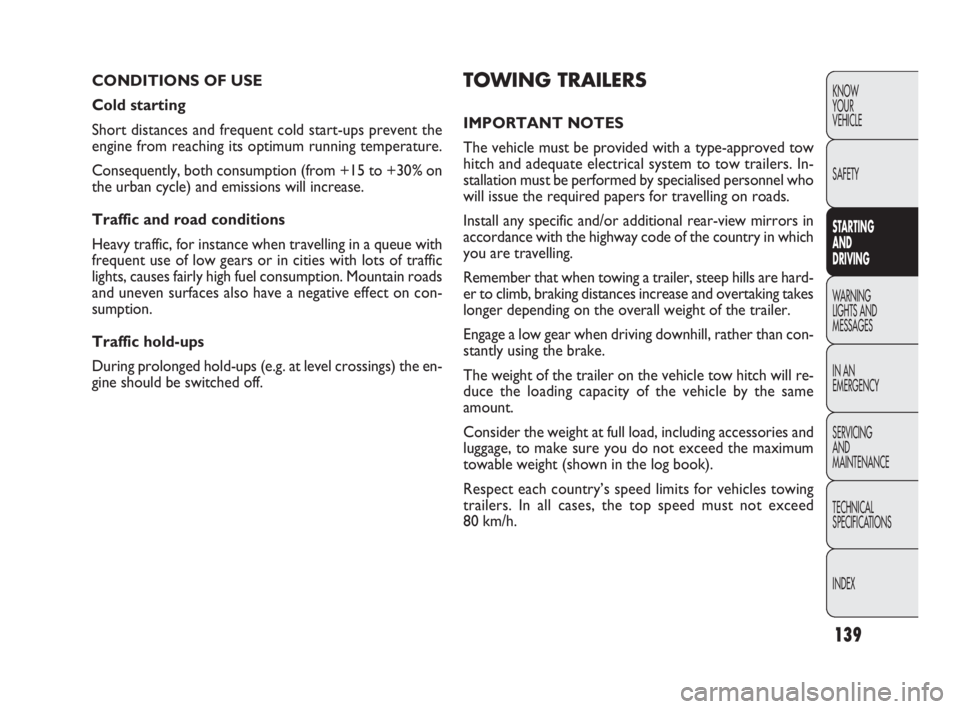
139
KNOW
YOUR
VEHICLE
SAFETY
STARTING
AND
DRIVING
WARNING
LIGHTS AND
MESSAGES
IN AN
EMERGENCY
SERVICING
AND
MAINTENANCE
TECHNICAL
SPECIFICATIONS
INDEX
TOWING TRAILERS
IMPORTANT NOTES
The vehicle must be provided with a type-approved tow
hitch and adequate electrical system to tow trailers. In-
stallation must be performed by specialised personnel who
will issue the required papers for travelling on roads.
Install any specific and/or additional rear-view mirrors in
accordance with the highway code of the country in which
you are travelling.
Remember that when towing a trailer, steep hills are hard-
er to climb, braking distances increase and overtaking takes
longer depending on the overall weight of the trailer.
Engage a low gear when driving downhill, rather than con-
stantly using the brake.
The weight of the trailer on the vehicle tow hitch will re-
duce the loading capacity of the vehicle by the same
amount.
Consider the weight at full load, including accessories and
luggage, to make sure you do not exceed the maximum
towable weight (shown in the log book).
Respect each country’s speed limits for vehicles towing
trailers. In all cases, the top speed must not exceed
80 km/h. CONDITIONS OF USE
Cold starting
Short distances and frequent cold start-ups prevent the
engine from reaching its optimum running temperature.
Consequently, both consumption (from +15 to +30% on
the urban cycle) and emissions will increase.
Traffic and road conditions
Heavy traffic, for instance when travelling in a queue with
frequent use of low gears or in cities with lots of traffic
lights, causes fairly high fuel consumption. Mountain roads
and uneven surfaces also have a negative effect on con-
sumption.
Traffic hold-ups
During prolonged hold-ups (e.g. at level crossings) the en-
gine should be switched off.
133-142 DOBLO LUM EN 2e 7.0 21-05-2010 11:12 Pagina 139